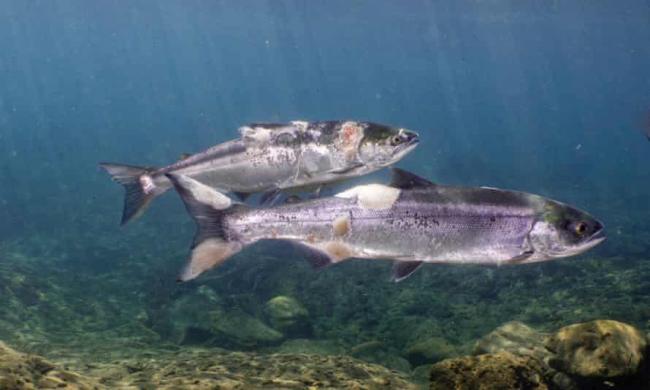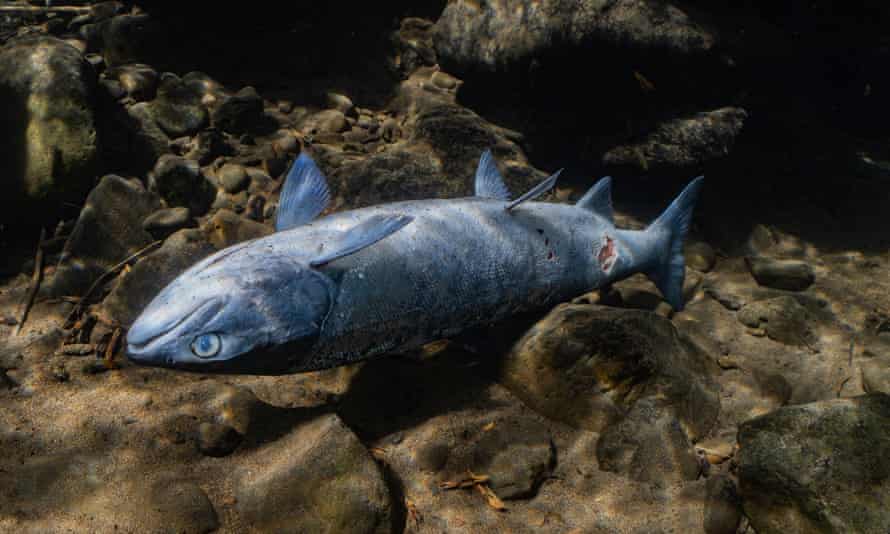Articles Menu

July 27, 2021
Salmon in the Columbia River were exposed to unlivable water temperatures that caused them to break out in angry red lesions and white fungus in the wake of the Pacific north-west’s record-shattering heatwave, according to a conservation group that has documented the disturbing sight.
In a video released on Tuesday by the non-profit organization Columbia Riverkeeper, a group of sockeye salmon swimming in a tributary of the river can be seen covered in injuries the group say are the results of stress and overheating.
The salmon had been traveling upstream in the Columbia River from the ocean, to return to their natal spawning areas, when they unexpectedly changed course, explained Brett VandenHeuvel, the executive director of Columbia Riverkeeper. He described the sockeye as veering off to the Little White Salmon River, a tributary of the Columbia River where the video was recorded, in an effort to essentially “escape a burning building”.
The conservation group recorded the video following the heatwave on a day when water temperatures breached 70F (21C), a lethal temperature for these anadromous fish if they are exposed to it for long periods. The Clean Water Act prohibits the Columbia River from rising over 68F (20C).
VandenHeuvel compared the situation to a person trying to run a marathon in over 100F (38C) temperatures.
“The difference is that this isn’t recreation for the salmon,” he said. “They have no choice. They either make it or they die.”
The salmon in the video won’t be able to spawn in the tributary, and are expected to die from disease and heat stress.
This scene is yet another example of the tragic toll taken by the recent heatwave, which killed hundreds of people across the Pacific north-west and Canada, probably caused more than 1 billion marine animals to perish, and contributed to fires across the region.
But VandenHeuvel said the incident went beyond the heatwave, and was exacerbated by the many dams that for decades have held up the water flows across Washington state and beyond, and thus increased water temperature. Climate change and the recent deadly heatwave simply threw the situation to the extreme.
A videographer captured the scene for the Columbia Riverkeeper earlier this month as part of the organization’s effort to try to keep track of the salmon’s progress in the heat.
VandenHeuvel said it was too early to say exactly how many salmon have died as a result of the hot water. But there are tens of thousands of sockeye still in the Columbia and Lower Snake rivers, and so as these waterways grow hotter over the next two months, many more fish could die. And given that Snake River sockeye are already considered endangered, the death of just a small section of their population could have dire effects.
VandenHeuvel recalled traveling out to the area in the days after the video was recorded, and said he saw salmon suffering in a similar way in other tributaries. He even spotted several sockeye carcasses downstream.
“It’s heartbreaking to watch animals dying unnaturally,” he said. “And worse, thinking about the cause of it. This is a human caused problem, and it really makes me think about the future.”
In the video, the salmon can be seen with what looks to be fuzzy white patches, which is likely a fungal infection that appears when salmon become stressed from hot water.

Don Sampson, a member of the Confederated Tribes of the Umatilla Indian Reservation and an advisory board member for the Northwest Tribal Salmon Alliance, described watching the video as akin to seeing his relatives die.
“That’s how bad I felt,” said Sampson, who is also hereditary chief of the Walla Walla tribe. “I mean I was near in tears when I saw it.”
He compared it to 2015, when about 250,000 sockeye died in the Columbia River and its tributaries after an especially hot summer.
Sampson predicted that the situation was only going to get worse, and said it was vital to move forward with a proposal of breaching four dams in eastern Washington state.
“It’s really appalling that we have solutions to save salmon, but we’re not doing it,” said Sampson. “We don’t have the political will, our members of Congress in the north-west don’t have the political strength or will to stand up to protect salmon for future generations.”
VandenHeuvel agreed that these types of scenes would continue to play out if officials did not take direct action.
“I see this as a deeply sad vision for our future. But I also see it as a call to action. There’s mitigation measures we can take to save the salmon, to cool our rivers,” he said. “And if this video doesn’t inspire some serious reflection, then I don’t know what will.”
[Top photo: Red lesions and white fungus on the salmons’ bodies are the result of high water temperatures and stress. Photograph: Conrad Gowell/Courtesy of Columbia Riverkeeper]